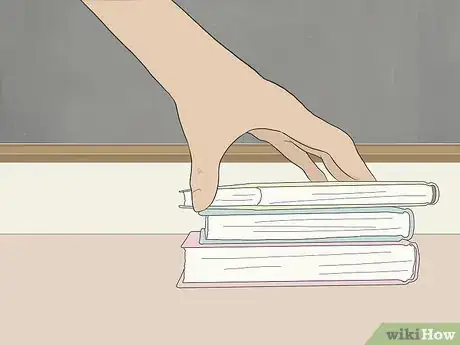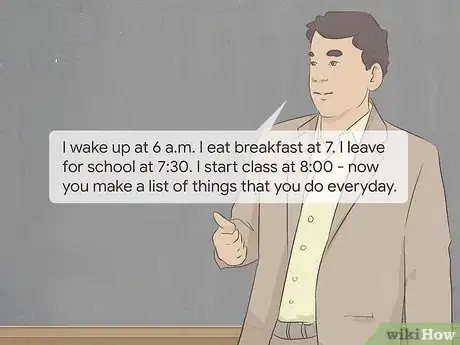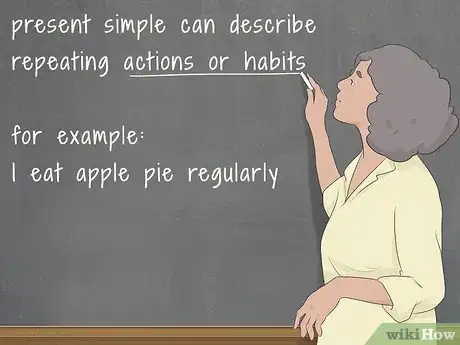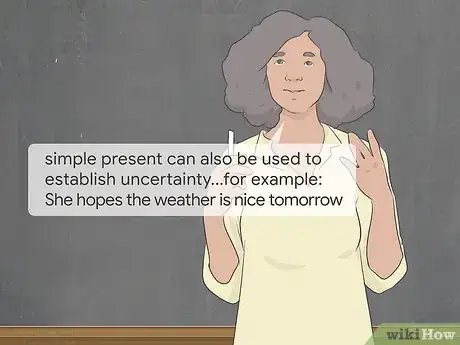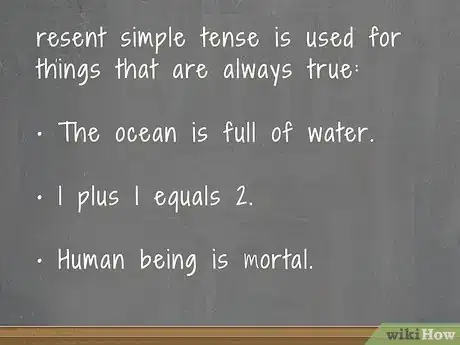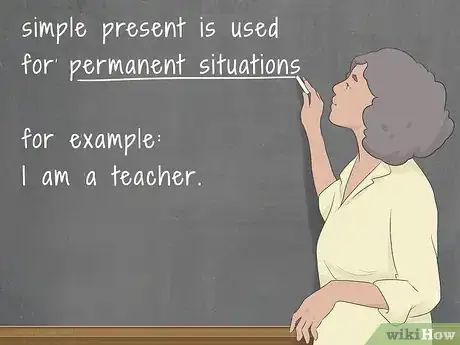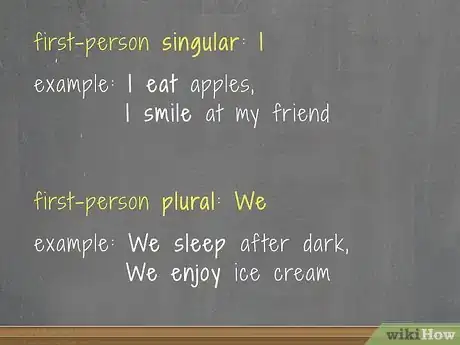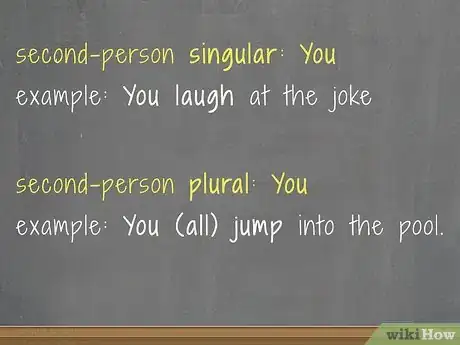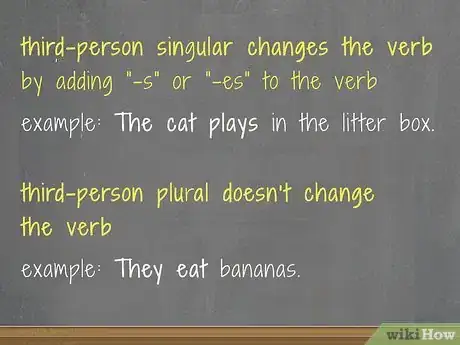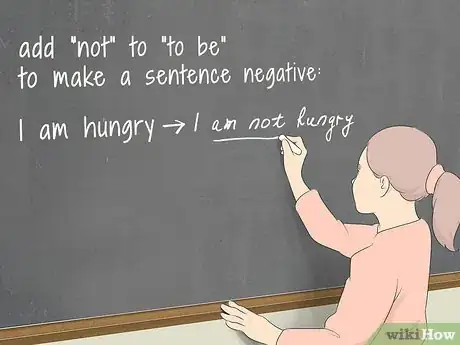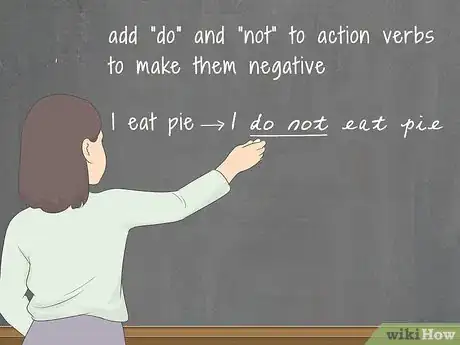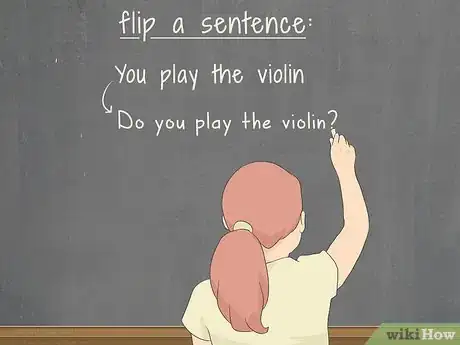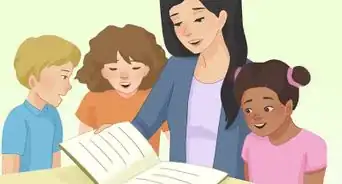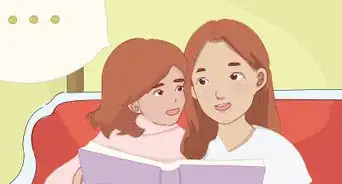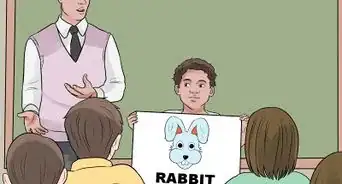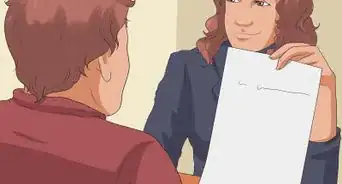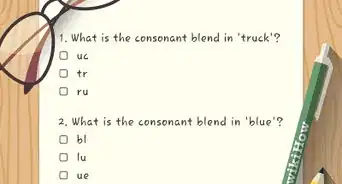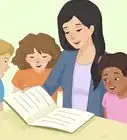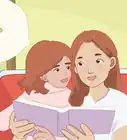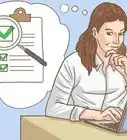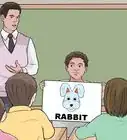This article was co-authored by wikiHow Staff. Our trained team of editors and researchers validate articles for accuracy and comprehensiveness. wikiHow's Content Management Team carefully monitors the work from our editorial staff to ensure that each article is backed by trusted research and meets our high quality standards.
There are 13 references cited in this article, which can be found at the bottom of the page.
This article has been viewed 36,805 times.
Learn more...
In theory, the simple present tense is the easiest tense in the English language, but that doesn't mean it's simple to learn! The best thing is to start out introducing your students to an action and then work on saying it in the present tense. Then, you can talk about the different ways present tense is used. Move on to discussing how to conjugate verbs in the present tense, and finally, work on negatives and questions. Once you introduce these subjects, have your students practice them together as a class, in groups, and individually to really get the material down!
Steps
Introducing Present Tense
-
1Start with an action and a simple description. Do something in front of your students that they can describe, such as picking up a book or writing on a piece of paper. Because present simple tense refers to verbs, starting with an action is an easy way to get the lesson going.[1]
-
2Ask the students to talk about your action. For instance, ask the students, "What did I just do?" They might say, "You picked up a book," or "You lifted that book." You can write that on the board.[2]
- You could also look at your computer or do jumping jacks. The action doesn't matter.
Advertisement -
3Re-word the sentence into simple present tense. Ask the students what the action word is in the sentence. Underline the word, and then re-write the sentence so it's in first person and simple present tense.[3]
- For example, you could underline "picked" or "lifted," and then re-write the sentences as "I pick up a book," or "I lift the book." Underline the verb again.
-
4Have students make a list of things they do every day. Start by giving them examples of what you do, such as, "I wake up at 6 a.m. I eat breakfast at 7. I leave for school at 7:30. I start class at 8:00." Then, have the students try making a list of their daily schedule.[4]
- Emphasize that it's just an example. Obviously, some days their schedule is different, so just have them pick an example day.
Showing When Present Tense Is Used
-
1Explain how simple present tense is used for short actions happening now. Talk about how the most basic use of the present tense is to describe something you're doing right now. Typically, it's only used for relatively short actions, as otherwise, you move to present perfect or present continuous, which describe longer actions in the present.[5]
- As examples, you might say, "The dog takes a nap on the patio" or "Jessica grabs the marker and hurries to the whiteboard."
-
2Look at how the simple present tense can be used to express states. In this case, "states" refers to states of being. Even though these can and do change, explain that you use the present tense because it is happening in the present moment. "States" can be things like feelings or conditions.
- Show how this is true with examples like, "John feels sad," "The cat is asleep on the couch," or "James is sick."
-
3Discuss how present simple can describe repeating actions or habits. Because habits are continuous, you talk about them in the present. This use works best if the sentence includes a time clause.
- As examples, you could use things like, "I eat apple pie regularly," or "I jog twice a week."
-
4Establish how you can discuss future scheduled events with present tense. When discussing a future event with present tense, let your students know it's important to include the time or day for the event. Explain the reason you can use present tense with these is because you're working with the facts you have in the present on a set schedule.[6]
- For instance, you might use examples such as "The train leaves the station at 8:00 p.m. tomorrow," or "The conference begins at 8 a.m. on Tuesday."
-
5Explore how simple present can establish uncertainty. Discuss how the present tense can work to talk about uncertainty, such as wishes or hopes. The present tense works for this purpose because you are feeling these uncertainties in the present.
- Some examples you could use include, "She hopes the weather is nice tomorrow," "I wish this ice cream had chocolate in it," or "They think the dog will be ready Thursday."
-
6Show how present simple tense is used for things that are always true. Explain how present simple tense makes sense in this situation because the statement never changes. No matter when you say it, it will always be true in the present. Give examples of always true statements to help your students understand.
- For instance, you could say things like, "The ocean is full of water," or "1 plus 1 equals 2."
-
7Examine how simple present is used for permanent situations. A "permanent" situation could be something like stating where you live or your career. Discuss how this case is similar to statements that are always true. That is, because a permanent situation stays true for a long time, you state it in the present tense until it changes.[7]
- Use examples like, "I live in Connecticut," or "I am a teacher."
Examining Point of View and Conjugation
-
1Explore first-person singular and plural with appropriate verb usage. Discuss how first-person singular uses "I." Talk about how most verbs take their most basic form when using first-person singular, such as "eat," "sleep," or "smile."[8] For first-person plural, use "we," and in this case, you also use the most basic form of the noun.
- For instance, you could say, "I eat apples," or "I smile at my friend." Alternatively, you could say, "We sleep after dark," or "We enjoy ice cream."
-
2Work on second-person singular and plural verb usage. Explain that "you" can be used for both singular and plural, though you can also say "you all" for plural. In this case, you also use the most basic form of the word, such as "laugh," "jump," or "slip."[9]
- For example, you could say, "You laugh at the joke," or "You (all) jump into the pool."
-
3Explore third-person singular and how the verb changes. Let your students know they can use "he," "she," or "it" for third-person singular or a singular noun or person's name, such as "James." For plural, work on using "they" or more than one name, such as "Jacob and Becky." Discuss how third-person singular is the one that changes the verb by adding "-s" or "-es" to the verb, such as "bounces" or "eats," but third-person plural keeps the basic form of the word.[10]
- For examples in third-person singular, you could use, "He bounces a ball," "Becky eats ice cream," or "The cat plays in the litter box." For third-person plural, try, "They eat bananas," or "Jacob and Becky jump on the trampoline."
-
4Discuss the use of the verb "to be." "To be" is one of the most commonly used verbs, but it's also one of the most irregular, meaning it doesn't conjugate the same way as regular verbs. In simple present tense, its most often used to establish a state of being, such as "I am happy."[11]
- The conjugation for this verb is "I am," "You are," "He/she/it is," "We are," "You (all) are," and "They are."
- You could write sample sentences such as "I am satisfied," "You are pretty," "She is nice," "We are fun," "You (all) are smart," or "They are funny."
- While there are other irregular verbs, they follow standard patterns in the present tense, either adding "-s" or "-es" in the third person singular. For example, "to go" becomes "He goes."
Working on Negatives and Questions
-
1Have students add "not" to "to be" sentences to make them negative. Write out positive sentences using the verb "to be" on the board and show them a few examples of how to add "not" after the verb. Then work as a class or individually to figure out how to make the rest of the sentences negative.[12]
- For instance, you could write, "I am hungry," "You are a goofy person," and "She is happy."
- They would write, "I am not hungry," "You are not a goofy person," and "She is not happy."
-
2Work on adding "do" and not to action verbs to make them negative. Do the same as you did with the verb "to be," but this time use action verbs that require adding the words "do not" or "does not." Give students examples, then have them work out sentences on their own. Note how third-person singular changes back to the basic form of the word when you add "does not" in front of it.[13]
- For example, you could write, "I eat pie," "You jump on the desk," and "He loves grammar."
- To make them negative, they would write, "I do not eat pie," "You do not jump on the desk," and "He does not love grammar."
-
3Let students flip sentences around to make questions. Give students examples of how to turn simple sentences into questions by adding "do" or "does" and flipping the word order. Then, ask them to work on the rest of the examples.[14]
- You could write, "You play the violin," "She jumps on the trampoline," and "They watch the cats," which would turn into, "Do you play the violin?" "Does she jump on the trampoline?" or "Do they watch the cats?"
References
- ↑ https://busyteacher.org/3560-how-to-teach-the-present-simple.html
- ↑ https://busyteacher.org/3560-how-to-teach-the-present-simple.html
- ↑ https://learnenglish.britishcouncil.org/english-grammar-reference/present-simple
- ↑ https://busyteacher.org/3560-how-to-teach-the-present-simple.html
- ↑ http://teach.files.bbci.co.uk/skillswise/en32tens-l1-f-the-simple-present.pdf
- ↑ https://www.cambridge.org/grammarandbeyond/grammar-practice-activities/2015/03/describing-the-future-with-the-simple-present
- ↑ https://learnenglish.britishcouncil.org/english-grammar-reference/present-simple
- ↑ https://www.bbc.com/bitesize/articles/zxdhsg8
- ↑ https://www.bbc.com/bitesize/articles/zxdhsg8
- ↑ https://www.bbc.com/bitesize/articles/zxdhsg8
- ↑ http://guidetogrammar.org/grammar/to_be.htm
- ↑ https://web2.uvcs.uvic.ca/courses/elc/studyzone/330/grammar/presnq.htm
- ↑ https://web2.uvcs.uvic.ca/courses/elc/studyzone/330/grammar/presnq.htm
- ↑ https://learnenglish.britishcouncil.org/english-grammar-reference/present-simple
